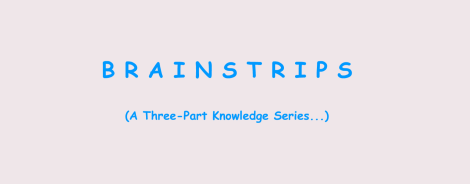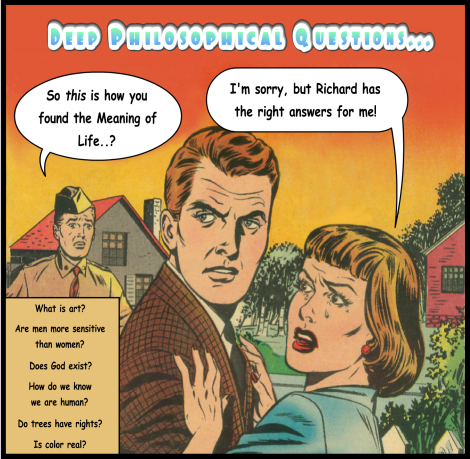by Matthew Scherger (matthew.scherger.16@cnu.edu)
Peer reviewed by Sydney Lee and Jess McDonnell
 Prezi Format
Prezi Format
Brainstrips. A web comic series created in 2009 by digital media artist and Humanities professor Alan Bigelow. It is interactive, and combines text with audio, animations, and video to create a narrative where Bigelow challenges his audience to think “outside the strip,” so to speak. It is part story, part art, and completely digital in nature, impossible to create without the digital format. But is that enough to classify Bigelow’s Brainstrips as a “Digital Humanities” project? Or is it simply another amusing corner of the internet to stumble upon and soon forget?
What are the digital humanities and why are we concerned with them? According to Digital_Humanities, “The disciplines that make up the modern humanities…have sought to define culture and help us gain a greater understanding of the human experience” (Burdick et. al, 4). Although it is tempting to group all projects in the Humanities that have a digital element to them as “Digital Humanities” projects, according to Burdick there are a few methodologies to determine if a work has crossed the line from the Humanities over to the Digital Humanities: curation, analysis, editing, and modeling (Burdick et. al, 5). A true Digital Humanities project will have one or more of these elements in digital form in a way that would change the work in a way that would be impossible without that digital element. In addition, the digital environment should alter projects in terms of “material composition, authorship, meaning-making, circulation, reading, viewing, navigation, embodiment, interactivity, and expressivity” (Burdick et. al, 29). These stipulations, while vague, have incredible influence on a project from how its created to how its received and even archived, which is the entire point of the subcategory of the Digital Humanities. The digital element should not be applied to projects just as a way of archiving current types of media; it should also be used to create and innovate in ways that would be unimaginable without the modern digital environment.
With all this in mind, does Bigelow’s Brainstrips count as “true Digital Humanities?” First, it’s best to examine it as a Humanities project. Above Burdick defined the modern field of Humanities as a way to “define culture and… gain a greater understanding of the human experience.” Under this determination, the Brainstrips pass; not only do they present factoids about science and math, in each of the three parts of the series Bigelow asks questions about our society and how we view the world: How are we applying the sciences? What do we view as art? How self-aware are we as a species?

All of these questions attempt at gaining understanding about our world and how we experience life. A resounding pass for the Humanities. Now for the real test: do the digital elements presented alter the project in such a way that would be impossible without them? On a surface level, it is a web comic that combines text elements with audio, video, and animation. Although the coding behind the web comic is surprisingly simple, the fact is that the form that the series is presented in on its own would be impossible to replicate entirely in print form. It was created in Flash, an application that requires knowledge of digital elements, and was distributed initially through a web journal as well as Bigelow’s personal website: http://webyarns.com/ . In addition, it requires the user to interact with it to provide meaning beyond a white webpage with the word “Brainstrips” written in bold blue text. As outlined above, the Brainstrips appears to check all the boxes in terms of what Burdick considers a Digital Humanities project to be and achieve. For me, the test is incredibly simple, however. I consider Brainstrips a Digital Humanities project simply because the experience of interacting with the web comic is greater than I could possibly describe in a print format such as this one. This is proof that it transcends the definitions of the Traditional Humanities and fully enter the realm of the modern Digital Humanities.
Still unconvinced? At the end of all three sections, there is a test. Although it’s presented as a “Higher Math” test, it is really a self-evaluation, multiple choice, test that asks you to assign numerical values to your self-esteem, reliability, and ability to love, and grades you at the end. Behind the complete absurdity of creating a test like this, Bigelow is challenging everyone to think about how they live their lives, how others perceive you, and how you perceive yourself. No matter how you answer, Bigelow ends with a short, extremely fast-paced monologue spoken over cracking audio pops, that is easy to miss upon your first run through. In its entirety it goes like this: “What’s so difficult about higher math? Sure, it’s higher, but it’s not that much higher, how much higher can you get? I mean, what’s it take? Follow an easy equation: Be a good person, do your best, love one another, do unto others, be virtuous, kind, true, considerate, gentle, understanding, empathetic, non-violent, good person.” Here Bigelow flips his entire project on its head in less than twenty-five seconds. This is a direct call out against the cultural trend over the last decade; where people are separated from each other by the screens in front of us and treat our fellow humans as we would another device in our lives. Instead, Bigelow challenges us to use the time and technology wisely; not to accrue knowledge and enlightenment (which we originally came to his Brainstrips to seek), but to seek out experiences with other humans and truly live. It is an embodiment of an attempt to define our culture and understand humanity, and it is this final part that propels the Bigelow’s Brainstrips from an internet distraction to a powerful message to our society as a whole.
Are you ready to be challenged by the Brainstrips?